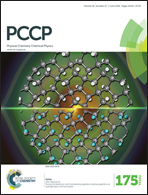Nanoscale heterogeneity in thermoelectrics: the occurrence of phase separation in Fe-doped Ca3Co4O9†
Abstract
The misfit layered cobaltate thermoelectrics are good candidates for high temperature thermoelectric applications. Ca3Co4O9 is a typical compound of this family, which consists of rock salt Ca2CoO3 slabs alternating with hexagonal CoO2 slabs with a large lattice mismatch along the b axis. Each slab is 0.3–0.5 nm thick and shows an inherent structural heterogeneity at the nanoscale. The latter is a key parameter that affects the electrical transport and the heat flow in these misfit structured thermoelectrics. To clarify the physical origin of the thermoelectric performance of iron doped Ca3Co4O9 we combined X-ray near-edge absorption spectroscopy (XANES) and quantum modeling using density functional theory. In contrast to single-site doping, the iron doping first occurs at the Co1 site of the rock salt slab at low doping while at higher doping it prefers the Ca1 site of the rock salt slab. Doping at the Ca1 site modifies the electronic structure tuning the nanoscale structural heterogeneity. This mechanism may open a new route to optimizing the thermoelectric performance of misfit layered thermoelectrics.


 Please wait while we load your content...
Please wait while we load your content...